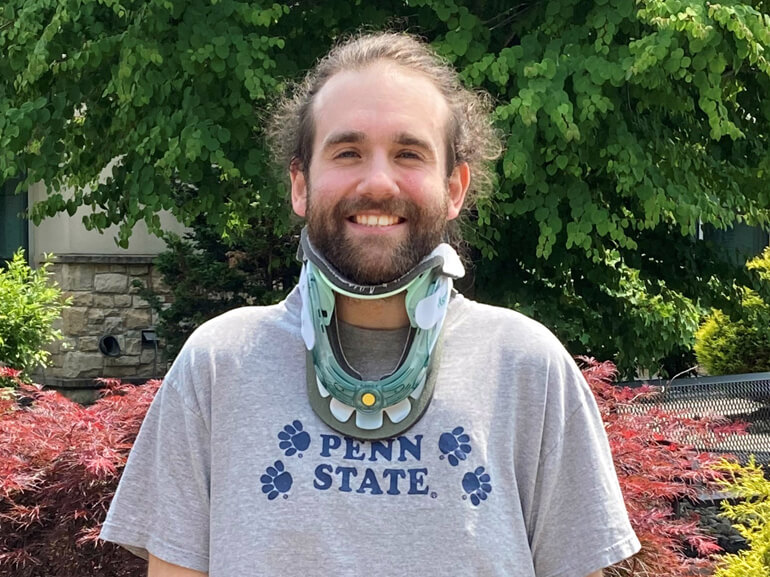Brad's story

Brad Sottile, 32, woke up early one morning and headed to the bathroom. Feeling dizzy, the Penn State assistant teaching professor made a U-turn back to bed but lost consciousness and fell into the nightstand, hyperextending his neck. When he regained consciousness, he couldn’t move his arms or legs. “I thought I was locked in,” Brad said.
Brad’s wife, Tiffany, a nurse practitioner, quickly stabilized his spine and called EMS. A medevac flight rushed him to Geisinger Medical Center in Danville, where he was diagnosed with a spinal cord injury in his neck and admitted to the Neuro Intensive Care Unit.
The father of two went into surgery five days later to fuse two of the cervical bones in his neck. He thought he was on the road to recovery when he took a turn. His heart stopped and his medical team took action to begin CPR, but just seconds later, his heart restarted. Brad recalls regaining consciousness and seeing his wife crying as he asked what happened.
Later that evening, Brad was undergoing a routine catheterization for urinary retention, a common complication after spinal cord injury, when his heart again stopped briefly. After recovering from the second episode, his cardiologist diagnosed him with an extreme form of a vasovagal episode, a loss of consciousness from a sudden nervous system-induced drop in blood pressure and heart rate.
Twelve days after his surgery and with a pacemaker in place to regulate his heart rate, Brad was ready for the next phase of his recovery. For that, he and his wife choose Penn State Health Rehabilitation Hospital due to the hospital’s top-notch care, proximity to family, and his Penn State connection.
Brad was diagnosed with an incomplete spinal cord injury, central cord syndrome, which is where the upper extremities are more affected than lower extremities. On evaluation by his physical therapy (PT) team, Brad was able to walk with minimal assistance, but not for long distances or periods of time due to endurance and balance challenges. The goal of rehabilitation was to focus on the neurological recovery of Brad’s arms and hands using specific targeted exercises that combined neurological and muscular skills such as typing, self-feeding, dressing, and fine motor skills. PT also worked to increase his overall balance, endurance, and mobility through therapies that addressed whole body conditioning and movement.
In occupational therapy (OT), the team also initially focused on Brad’s upper extremity limitations, directing him in exercises to grasp/release pegs and place them into peg board, to retrieve small beads from thera-putty while focusing on manipulation and fine motor skills, and to reach and retrieve items to improve coordination.
Brad’s goal for himself was simple: to return to “normal” life as a husband and father and re-immerse himself back into his teaching and research in the College of Engineering at Penn State – a calling that he loves and one he enjoys sharing with his students. His mantra at the hospital became “I’m here to work,” and he embraced therapy activities to help achieve his goals.
Therapies Brad found particularly helpful in moving him toward his goals included stability exercises while walking, obstacle courses that honed his balance, activities that allowed him to practice getting up and down in preparation for returning home and playing with his children, and finger dexterity and strength exercises to rebuild muscle and function in his arms and hands. When he finished an exercise, Brad would ask “What can I do next?” Brad said his resilience surprised him, even overcoming a fear of needles.
Brad said his biggest motivator was getting stronger in order to return home and support his wife and family. He reached that goal after 17 days of inpatient rehabilitation. When he left Penn State Rehabilitation Hospital, Brad could walk independently, type, feed himself, hug his children, get down and up from the floor to play with his children, and take care of all his self-care needs including dressing and grooming.
His message to others facing similar challenges is simple: “Take one day at a time. Keep fighting. If you don’t, no one else will. Physical and occupational therapy only works if you participate in it."